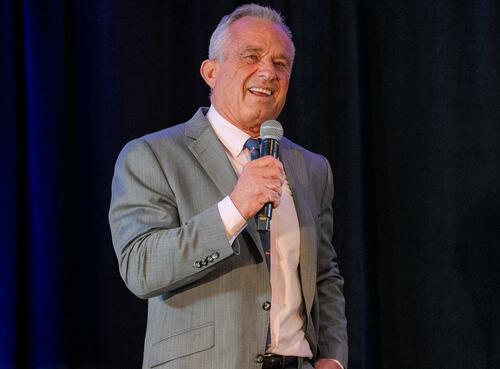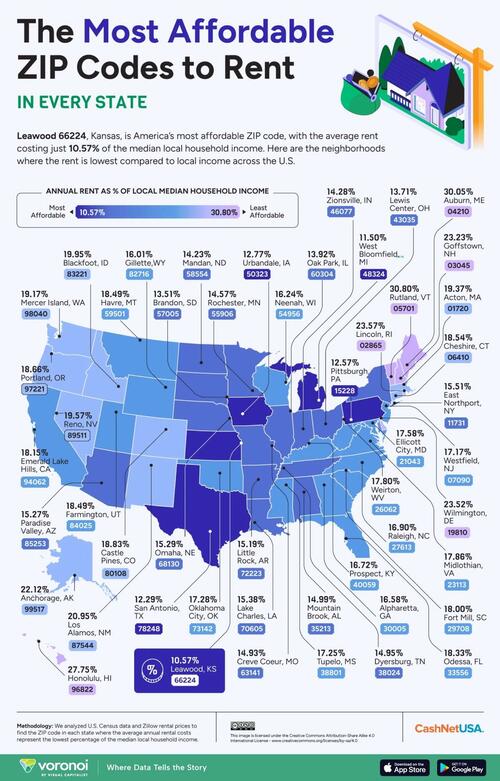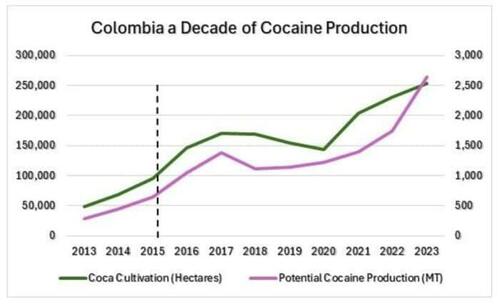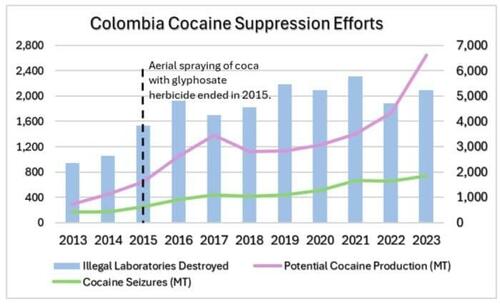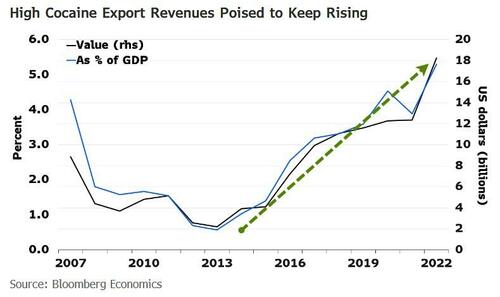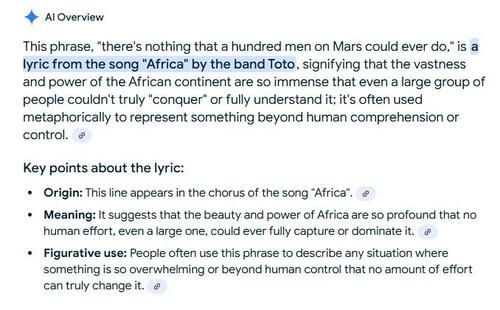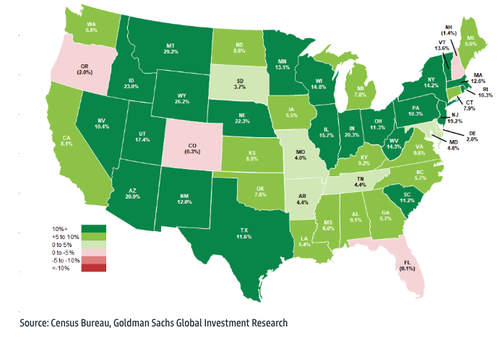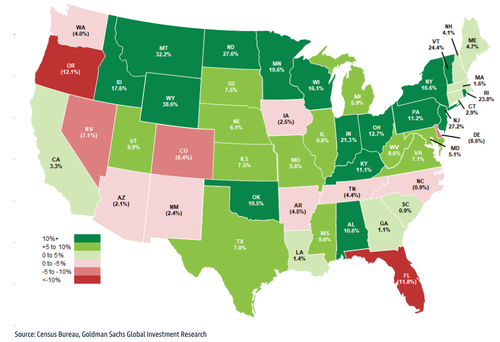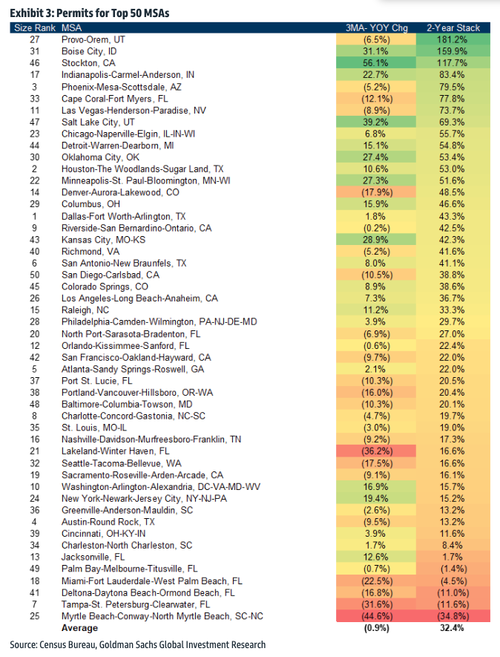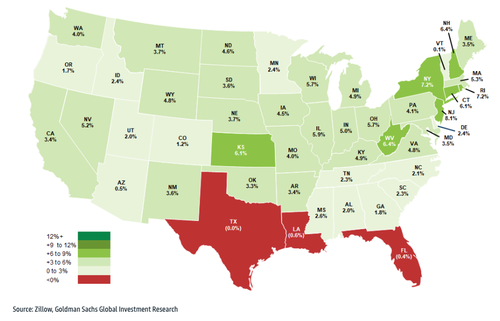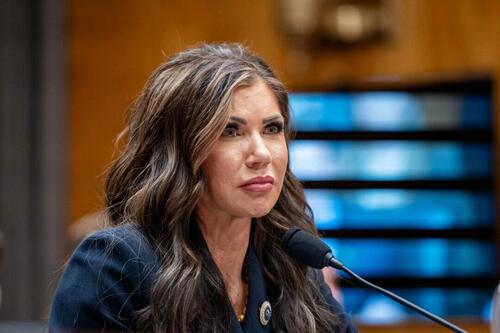Authored by David Stockman via The Brownstone Institute,
The following is excerpted from Chapter One of David Stockman’s latest book, How To Cut $2 Trillion: A Blueprint From Ronald Reagan’s Budget Cutter To Musk, Ramaswamy And The DOGE Team.
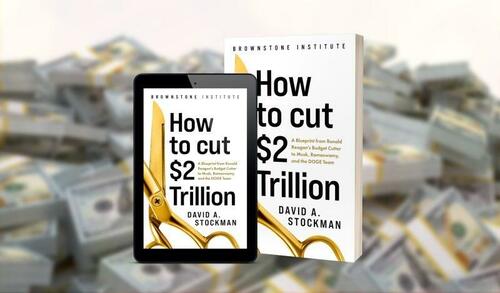
Under our three savings bucket scheme, “Slashing the Fat” from the Federal payroll and bureaucracy would account for just $400 billion or 20% of DOGE’s $2 trillion per year savings target. Needless to say, however, even that small portion would be far easier said than done.
That’s because, unlike the case of typical US businesses, where payroll costs can range from 15% to 40% of total costs, such expenses comprise only a tiny fraction of total Federal spending. Setting aside DOD payrolls for the “Downsize the Muscle” bucket, we estimate fully-loaded nondefense employee compensation costs at $215 billion in the target year of FY 2029. That’s just 3.1% of the $7 trillion of nondefense outlays projected under current policy by CBO for what would be the final Trump budget.
So there is a lot of wood to chop in other areas of nondefense spending, but we start with the assumption that $85 billion or 40% of nondefense payroll costs would be a fair component of a broader plan to generate the $400 billion of “Slash the Fat” savings. At the projected FY 2029 cost of $160,000 per Federal employee for payroll, benefits, and fringes, this would require termination of 535,000 positions from the current total of 1,343,000 nondefense employees.
On its face, this headcount reduction target is eminently plausible given that the Washington Swamp is a vast cesspool of padded payrolls, useless projects, endemic inefficiency, and misbegotten government enterprises. But what is especially telling is that our 40% payroll cut would amount to just half of the 80% staff reduction that Elon Musk achieved at the old Twitter. And he did so in the context of a labor-intensive business without missing a beat in terms of operations and customer accommodation at the new “X.”
So we begin the payroll savings analysis by bringing the hammer down terminally on the 16 worst and most unneeded Federal agencies, including the FBI, OSHA, the FTC, and the Department of Education. Eliminating these 16 bureaucracies entirely would reduce Federal employment by 71,000 jobs and save $11.1 billion per year of direct compensation costs. That’s nothing to sneeze at, of course, but to place it in budgetary context it does represent only 13 hours’ worth of the $8.0 trillion per year of total baseline Federal spending for the target budget year of FY 2029.
We also show that cutting 50% of the staff levels at another 9 dubious departments–including the EPA, NASA, and GSA–would shrink the Federal payroll by an additional 93,000. That would save a further $15 billion annually in compensation costs.
Still, we would need an additional $59 billion in nondefense savings to achieve the $85 billion target for direct compensation reductions. Accordingly, upwards of 371,000 positions would need to be eliminated from the balance of the nondefense agencies or about 34% of the 1,084,000 current jobs at everything from the Agriculture Department to the Social Security Administration and Veterans health care system.
In addition, we estimate that $85 billion in compensation cost savings would generate an additional $45 billion of indirect savings in the related costs for agency overhead, occupancy, supplies, and outside contractor services.
In summary, therefore, we’d propose that about one-third of the “Slash the Fat” savings target of $400 billion be obtained from the following areas inside the four walls of nondefense government. Chapter 6 will also outline $270 billion of savings from outside the walls of nondefense government in the form of cuts in corporate welfare, farmer subsidies, the Green New Deal, and other wasteful private sector subventions.
Summary of Savings From Headcount and Nondefense Agency Waste Reductions (FY 2029):
-
100% Elimination of Staffing at 16 Unnecessary Federal Agencies: $11 billion.
-
50% Staffing Cut at 9 Dubious Federal Agencies: $15 billion.
-
34% Staff Reduction at All Other Nondefense Departments: $59 billion.
-
Indirect Overhead savings from nondefense staff reductions and agency eliminations: $45 billion.
-
Total Nondefense Staff and Overhead Savings: $130 billion.
We begin with a summary of the 16 agencies to be shut down, along with the number of staff positions to be eliminated and the resulting direct employee compensation savings. These agencies are slated for complete elimination because in the context of a roaring fiscal crisis, they are either utterly unnecessary or inappropriate functions of government or comprise activities that are already being handled by other Federal agencies, state and local governments, or the private sector.
Self-evidently, these 16 agency closures would result in only a small down payment against the $2 trillion per year savings goal. Yet it is crucial to start here because each of these agencies represent cases of egregious regulatory excess or Washington-based enterprises that are not remotely the business of the central government in any season, but most especially not during a time when the Federal government is careening toward the fiscal shoals.
Stated differently, the list below comprises a kind of Litmus Test of fiscal resolve.
If these Federal bureaucrats and agencies can’t be eliminated, the prospect for reining in America’s unfolding fiscal calamity is dim indeed.
16 Agencies To Be Eliminated–Staff Cuts and Payroll Savings:
-
National Endowment for the Arts: 100 staff and $16 million savings.
-
National Endowment for the Humanities: 100 staff and $16 million savings.
-
Legal Services Corporation: 800 staff and $128 million savings.
-
National Highway Traffic Safety Administration (NHTSA): 600 staff and $96 million savings.
-
Federal Trade Commission (FTC): 1,125 staff and $180 million savings.
-
Corporation for Public Broadcasting: 100 staff and $16 million savings.
-
OSHA: 2,200 staff and $352 million savings.
-
Consumer Products Safety Commission: 600 staff and $96 million savings.
-
Agency for Global Media: 1,125 staff and $180 million of savings.
-
National Endowment for Democracy (NED): 162 staff and $26 million savings.
-
Education Department: 4,245 staff and $680 million savings.
-
Consumer Financial Protection Bureau: 1,500 staff and $240 million savings.
-
Agency for International Development (AID): 10,000 staff and $1.6 billion savings.
-
FBI: 34,000 staff and $5.4 billion savings.
-
BATF: 5,300 staff and $848 million savings.
-
DEA: 9,315 staff and $1.49 billion savings.
-
Total 16 Agencies To Be Eliminated: 71,000 staff and $11.3 billion savings.
As it happens, many of the above listed agencies were on the original Reagan zero-out list of 1981. Yet they are still alive and prosperous because the Swamp is relentless in the defense of its own, and especially because on the margin even most of the GOP movers and shakers on the Congressional spending committees have been Washington lifers, RINOs, and political weaklings afraid to resist the politically correct dictates of the Washington establishment and their megaphones in the MSM.
National Endowments for the Arts and Humanities
For instance, they are still spending about $420 million per year on the National Endowments for the Arts and the National Endowment for the Humanities. Back in 1981, when the public debt was still under $1 trillion and 31% of GDP, we argued that the cultural institutions supported by the endowments should be funded by private philanthropy and public admission tickets to museums, operas, etc., not hard-pressed bus drivers in Milwaukee struggling to feed, clothe, and shelter their families; and most certainly not via borrowing from future taxpayers through endless deficit finance.
At the time, the net worth of the top 1% of households was about $3 trillion, indicating ample capacity among wealthy patrons to support America’s important cultural institutions and endeavors, along with the voluntary support of millions of other less prosperous but culturally engaged citizens.
Well, here we are 44 years later with a public debt of $36 trillion and heading skyward, while the net worth of the wealthiest 1% of US households has risen by 16X to $47 trillion. And that staggering wealth pile stands alongside an additional current net worth of $10 trillion for the next 9% of wealthiest households. Yet and yet: The clueless politicians on the Potomac are still borrowing money to fund cultural institutions when the top 10% of US households alone have $56 trillion of net worth available for support of the arts and humanities.
In this instance, we’d suggest that Elon Musk set the example by pledging $2 billion over the next five years to enable cultural institutions and artists time to locate alternative sources of funding, thereby permitting the national endowments to be zeroed out immediately. This would at least get the agency-elimination ball rolling with a bang!
To be sure, shutting down the two endowments would result in a reduction of only 200 Federal jobs and a compensation cost savings of just $32 million per year, but as we will detail below, it would also generate additional savings from grants and overhead of $390 million.
In any event, this is surely the place to start. After all, if the Trumpified Washington can’t even eliminate these two agencies, why then, truly, all is lost.
Legal Services Corporation
The same goes for the 800 staffers and $128 million of savings from eliminating the Legal Services Corporation. For crying out loud, this whole operation is a liberal hobby horse dating back to the early days of the War on Poverty in 1965.
If the dubious political litigation it mainly supports via direct staff and another $432 million of grants and contracts has not found non-Federal funding more than a half century later, it doesn’t deserve another dime from Uncle Sam. Period.
National Highway Traffic Safety Administration (NHTSA)
In the case of the NHTSA, we have the very worst of the Nanny State. It has not only usurped the role of the private market and legal liability system in determining appropriate engineering standards for auto safety, but for decades has been knee-deep in setting idiotic average fuel economy standards (CAFE) for the entire fleet of each automaker.
This causes immense distortions in vehicle offerings, pricing, and production sourcing. That’s because to meet fleetwide fuel economy mandates each automaker must average together the lower fuel economy ratings of heavier, higher performance and profitable vehicles the public actually wants to buy with the artificially high fuel economy levels of small, stripped-down, under-powered cars that they must be deeply discounted to move the metal owing to limited marketplace appeal. In the process of compliance, automakers also tend to shift sourcing of the latter small, cheap “compliance” vehicles to Mexico and East Asia in order to relieve the strain on profitability resulting from these largely unprofitable NHTSA-mandated autos.
Accordingly, we would propose to abolish the NHTSA and in one fell swoop get rid of 600 bureaucrats and an overall waste of $1.2 billion per year, including about $500 million of safety grants to the states. With respect to the latter, if the genius socialist legislators in Sacramento and Albany want to steer their own unwashed driving masses to purportedly safer modes of happy motoring, let them do so on their own taxpayers’ dime.
Abolition of the NHTSA would also return consumer vehicle choice to the marketplace and likely bring a lot of current foreign-sourced auto production back home. That is to say, most of today’s auto companies–both the Big Three and foreign brands–make a decent profit manufacturing full-sized sedans, SUV’s, and pickups in the United States. Upon abolition of the CAFE program, therefore, Nanny State-mandated and foreign-sourced econo-boxes would lose their helping hand from Washington, paving the way for more US-built vehicles on dealer lots that consumers actually wish to buy.
And, yes, if consumers want six airbags per car as now mandated by the NHTSA (standard sedans are required to have two frontal airbags, two side airbags and two curtain airbags to protect occupants in the event of a side-impact crash), manufacturers will offer dealer-installed options at the appropriate (steepish) markup to base sticker prices. Indeed, the idea that consumers need a Federal Auto Nanny in order to choose a “safe” vehicle goes back to Ralph Nader’s original grab for regulatory power back in the 1970s and 1980s, which we fought in Washington when at least some Republicans still understood the statist scam of alleged “market imperfections.”
Federal Trade Commission
America imports $3.1 trillion of goods every year, which is testimony in itself that planet earth is crawling with potential competitors, fair and unfair. This actual and potential competition militates against the ability of any domestic manufacturer to monopolize anything.
In fact, students of sound market economics have understood since at least the 1960s the populist idea that private capitalism is an incubator of monopoly is just plain nonsense. With extremely rare exceptions, monopolies and rigged oligopolies only arise when they are enabled by the state via regulatory favoritism and capture, subsidies, and/or protectionist restraints of both domestic and international trade.
So what Washington needs is not anti-monopoly policemen, but the elimination of crony-capitalist policies that bestow unfair and coercive competitive advantage on politically privileged competitors. Most certainly, therefore, two anti-monopoly bureaucracies are way beyond the ken, meaning that the FTC should be abolished entirely. If need be, any minor residual meddling with business in this area can be handled by a low-cost rump operation in a drastically downsized antitrust division of the DOJ.
Again, savings of $180 million per year of FTC compensation expense is more than warranted, even as it would free American business from Nanny State meddling that results from 1,125 FTC staffers scurrying around in search of imaginary problems to justify their salaries. And, as we will amplify below, there would be a bonus savings here of $250 million, representing the non-payroll waste incurred by the FTC.
Corporation for Public Broadcasting
Even back in the world of 1981, there was no case for public funding of radio and TV, but by the year 2024 it has become a screaming instance of “Oh, puleeeze!”
The powerful presence of “X” (nee Twitter) is testimony itself that the dominant hometown newspaper and three broadcast networks no longer have even a remote monopoly on the news. That was the ostensible reason for the government-funded NPR back in the day, which, predictably, was bypassed by the flowering of tens of thousands of technologically and market-based alternative media and news/information/entertainment venues. And then, even as NPR became redundant and utterly unnecessary, it morphed into a state propaganda agency to boot.
Accordingly, the CPB’s 100 staffers should be told to send their resumes to the blooming, buzzing world of alternative media on Day 1, even as the expense of $16 million for compensation and $520 million for affiliate grants and contracts is eliminated. Cold turkey would be the obvious way to serve up the savings in this case.
OSHA (Occupational Health and Safety Administration)
As it happens, there are approximately 90,000 units of state, county, city, village, and township government in the United States–the overwhelming share of which are involved in the business of grassroots public health and safety administration and enforcement in some form. So, if these manifold units of government can’t look after safety in the workplace–from farms to warehouses and factories–what’s even the point of the Founders’ genius? Namely, their acute understanding that healthy democracy requires a decentralized federalist form of the state, not a unitary power in a capital city distant from the daily life of the people and the marketplaces and communities in which they operate.
Beyond that, there is no absolute science of workplace safety. Always and everywhere, it involves a trade-off between levels of protection and costs, and also choices among an infinite array of engineering versus behavior approaches to safety–all of which have their pros and cons. That’s why a federalist approach is tailor-made for the very function and jurisdiction of OSHA.
That is to say, Justice Brandeis had the answer more than a century ago when he argued that the states were the proper laboratories of democracy and that many of the functions Washington has since usurped might be better experimented with and executed at the state and local level.
In the case of cowboy safety, for example, the California-style approach illustrated below might be appropriate for a state that lost its cowboys long ago, anyway. But Texas, which still has some, might well prefer a more practical and less burdensome approach.
In any event, 2,200 bureaucrats and inspectors on the OSHA payroll are absolutely unnecessary to insure safe workplaces in America. Not only would the elimination of OSHA save $350 million of staffing costs and $1.3 billion of annual Federal expense overall, but it would also relieve businesses and workplaces in America of literally billions of compliance costs and millions of hours of paperwork that represent the inherent overkill of a centralized bureaucracy that has become a captive of its own labor union constituencies.
Besides, we’d bet that Florida, the Carolinas, and Texas would be more than happy to accommodate the relocation of businesses that might be chased away by a mini-OSHA in Albany, Sacramento, or Springfield. That is, competition among the states for investment, jobs, and a favorable business climate is likely to be a far more powerful brake on regulatory agency excesses than the so-called Congressional oversight committees ever have been, or even the courts–neither of which have real skin in the game.

Consumer Products Safety Commission (CPSC)
Even more than OSHA, the Consumer Products Safety Commission is a case of the Nanny State run wild. When you look at the main product categories of its regulatory focus listed below, you have to wonder how in the world American consumers even dared go into a furniture mart, hardware store, or children’s toy emporium without risking the life and limb of themselves and their families before CPSC’s enactment in 1972; and also what the other 90,000 units of state and local government were doing with respect to the very prosaic matter of household product safety–to say nothing of parents and grandparents.
As to the latter, we have fond memories of a 12-foot-high swing our grandfather rigged up from the high limb of a big Maple tree in our backyard. He was undoubtedly not CPSC-compliant in his swing making, but he damn well knew what was safe for kids and therefore secured the ropes and seat far more safely than what happened when we kids used his swing to “bail out” in imitation of fighter pilots exiting a burning plane.
Then again, the free market has a very powerful incentive for vendors to make and sell safe products: Namely, the protection of their brand franchises and avoidance of devastating legal liability settlements for defective products, which settlements in today’s world can badly impair or even bankrupt a careless or crooked business. After all, the torts bar was a powerful health and safety line of defense for consumers long before the Nanny State even arose.
In any event, as in the case of workplace safety there is no “science” whatsoever with respect to “safe” baby cribs, adult mattresses, power drills, deodorants, or ATVs. It’s all a matter of trade-offs between cost and functionality, on the one hand, versus product safety, on the other. It also involves complex issues of engineering versus behavior-based risk mitigation, and ultimately turns on consumer preferences and risk propensities.
For instance, the “sport” of skydiving is both hazardous and fully legal, but an inherently safer ATV must have CPSC-compliant roll bars, seat belts, helmets, safety instruction manuals, and speed governors on models designed for younger drivers.
Indeed, if any of the products listed below actually require state-imposed regulation reaching beyond the inherent protections of liability law, there is still absolutely no reason to supersede the ample net of traditional regulation by state and local governments, trade associations, and insurers of product liability risk that existed before 1972.
Yet this very observation tells you all you need to know about Nanny State regulation. To wit, the CPSC has thrived politically over the decades since 1972 because crony capitalists have learned to love regulation from the Washington Swamp. Very simply, it avoids the inconvenience and costs of meeting different regulatory standards in California versus Utah and Indiana; makes for one-stop lobbying on K-Street; and creates barriers to entry for upstart competitors.
Then again, it is not the legitimate business of the Federal government to protect American businesses from the foolishness of regulatory zealots in the Socialist Republic of California or the New York Soviet in Albany. Once again, in fact, the only practical way to minimize wasteful and costly regulatory interference with the production and sale of the myriads of everyday consumer products listed below is via energetic competition between the states.
We are quite confident that the likes of Utah, Kansas, Tennessee, and Florida would find the right balance with respect to the safety of cribs, toasters, bicycles, and camping gear long before consumers were forced to march on Sacramento seeking regulatory relief from California-mandated high-cost and low-performance versions of these same products.
Functions of the CPSC:
-
Ensuring the safety of toys, cribs, strollers, and other children’s items.
-
Regulating items like furniture, mattresses, and household appliances to prevent injuries from fires, falls, and electrical hazards.
-
Ensuring the safety of sports equipment, bicycles, and playground equipment like slides and swings.
-
Ensuring that consumer electronics, including small appliances and power tools, meet safety standards to prevent electrical shocks and fires.
-
Regulating household chemicals, cosmetics, and personal care products to reduce risks of poisoning, burns, and other injuries.
-
Overseeing the safety of items like ATVs, boats, and camping equipment.
The Congressional foreign affairs and national security committees thrive upon globetrotting junkets and strutting around foreign lands as visiting plenipotentiaries of the American Empire. So they have found it inconvenient to acknowledge that the Cold War ended 34 years ago and that many of the institutions erected to fight it are now utterly obsolete, if they were ever necessary in the first place.
The prime example of this would be the string of US government propaganda agencies including the Voice of America, Radio Free Europe/Radio Liberty, Radio Free Asia, and the Middle East Broadcasting Network. These were all designed to counter exaggerated claims that the commies were on the march toward global domination and that the backward peoples of other nations needed to be educated as to this danger by enlightened patriots bivouacked on the banks of the Potomac.
Of course, the commies are now long gone. Well, unless you think the Red Capitalists of Beijing are really mobilizing a vast armada of 100 aircraft carriers and troop ships to disembark on the shores of California, thereby destroying their own global export trade, Ponzi economy, and basis for continued rule in the process.
To the contrary, of course, the picture is more nearly the opposite: The calamity of Vietnam, two pointless but bloody and destructive wars in Iraq, the veritable carnage visited upon Syria, Libya, and Yemen by American arms and the missiles and bombs stamped “Made in the USA” now raining down from the skies in Gaza, Lebanon, and Ukraine surely leave serious doubt about whether any of these obsolete propaganda agencies are convincing the unwashed masses anywhere on the planet to bend a knee toward Washington.
In any event, an America First national security policy focused on an invincible nuclear deterrent and safeguarding of the North American shorelines and airspace from conventional attack, as we will outline under the “Downsize the Muscle” basket in Chapter 7, doesn’t need to waste a single dime on the 1,125 bureaucrats employed by the parent agency of these Cold War relics. And that’s especially the case in an internet-saturated world where even the muscular dictators of Beijing and their Great Firewall of China can’t effectively suppress unauthorized communications emanating from outside the Middle Kingdom.
Abolishing the Agency for Global Media would thus save $180 million per year in direct compensation costs and an additional $770 million wasted on contractors, facilities, communications equipment, and rentals, etc. In a world with today’s communications technology, in fact, America is inherently, for good or ill, the proverbial light on the hill.
That’s because anything and everything which transpires here–from sea to shining sea–is transparent to the entire planet. The world now sees on the internet all that we do in real time and makes its own judgment. Washington doesn’t need to waste dollars it doesn’t have on the salaries of journalism school graduates peddling Warfare State propaganda in the process of building up their own resumes for more lucrative opportunities in the MSM.
National Endowment for Democracy (NED)
The 162 staffers and $315 million annual budget of NED are not only a waste, but also a purely destructive project of the Washington neocons and warhawks. We fought it tooth-and-nail when it was concocted in 1983 by neocons in the Reagan White House, arguing it would become a sinecure for Washington national security lifers who didn’t make the big grades at the CIA, State, and DOD.
We were right about that in spades. A former president of the Young People’s Socialist League (YPSL), Carl Gershman, became its first executive director in 1984 and was still there in 2021, when they finally gave him his gold watch. But like all former Trotskyites who turned neocon under the tutelage of the detestable Irving Kristol and his equally reprehensible son, Bill Kristol, Gershman spent the 37 years of his tenure carrying out the CIA’s regime-change function that was seconded to NED in the 1983 legislation.
Among all of the “color revolution” follies promoted by NED during these years, the most insidious was its role in organizing, funding, and enabling the Maidan uprising in Kiev during February 2014. That pointless exercise in regime change paved the way for the Washington-fostered putsch which installed neo-Nazi-sympathizers and militant Ukrainian nationalists in power in Kiev.
In turn, Washington’s illegal deposing of the legitimately elected Russian-speaking and Russian-sympathizing president, Viktor Yanukovych, who had won office in 2010 on the back of massive 80%+ margins in the Donbas, Crimea, and Black Sea rim, paved the way for the current civil war carnage, and disastrous proxy war on Russia. After all, the Ukrainian nationalists who were picked, named, and recognized by Washington quickly put joining NATO into Ukraine’s constitution, outlawed Russian language, and launched a brutal civil war against breakaway Russian-speaking regions, thereby eventually provoking the Russian invasion of February 2022.
Since then, the US has spent upwards of $150 billion on a pointless war of human and infrastructure destruction–a veritable demolition derby of senseless military intervention. And one which now threatens to bring Washington’s reckless proxy attack on Russia to the brink of nuclear confrontation. Yet the Ukraine disaster is the very quintessential work of NED. That alone merits its abolition–no more questions asked.
But, alas, there is another point. More than half of NED’s annual $300 million of taxpayer money is used to sustain the worst kind of Washington insider corruption, log-rolling, and self-justifying promotion of the Warfare State. To wit, half the funds are divided up among institutions controlled by the four big political powers which operate on the banks of the Potomac. That is, the union-promoted “American Center for International Labor Solidarity,” the business-sponsored “Center for International Private Enterprise,” the Democrat-controlled “National Democratic Institute for International Affairs,” and the GOP-controlled “International Republican Institute.” The purpose of these Beltway duchies, of course, is to fund cheerleaders for the projects of Empire abroad.
Moreover, for good measure, the balance of the $300 million goes to hundreds of NGOs based abroad. These are essentially the advance guard of Washington’s Empire First policies and should not get a dime under a regime of America First.
It can be well and truly said, therefore, that there is no conceivable waste more egregious and more rotten than that embodied in NED. It needs to be shot deader than bin Laden at the very earliest opportunity.
Education Department
Needless to say, the Education Department should never have been potted on the banks of the Potomac because education is meant to be a state, local, and parental function across the length and breadth of the land. Indeed, centralization and national dictation of educational processes, standards, content, and institutional arrangements is the very last thing that should come under the control of the central state.
The current education department came into existence, in fact, only in 1979 as a desperate Carter administration sop to the teachers’ unions, which were the backbone of his political coalition. Accordingly, an immediate shutdown of this still infant and unneeded department was a high priority on the Reagan administration’s zero-out list.
As it happened, however, squirrely GOP politicians on the Congressional education committees and a Secretary of Education who spent his time in office sabotaging the president’s budget prevented the Department from being strangled in the cradle as intended. Instead, the education lobby’s victory over the Reagan challenge enabled the new department to thrive without interruption for the next 40 years until reaching a monstrous $350 billion spending level at present.
Still, there is only one way to ensure free expression, diversity of pedagogical approaches, and unfettered experimentation in the education sector. To wit, abolish the Department of Education completely, spin off existing Federal grant activities in block grants to the states, at a reduced percentage of existing funding levels, and slash subsidized student aid by 40%, as we outline in Chapter 8.
Actually, this is not mission impossible. During 2024 the broad allocation of the Department of Education’s funding was as follows:
-
Elementary and secondary education grants and support: $52 billion.
-
Special Education, Adult, Career, and other Education programs: $18 billion.
-
Higher Education Pell Grants, Work Study, and other student direct aid: $30 billion.
-
Subsidized Student Loan Outlays: $250 billion.
-
Total, Federal Education Programs: $350 billion.
Needless to say, DOGE could dispense with the Department of Education’s 4,245 bureaucrats and their $680 million compensation costs in one fell swoop by proposing to eliminate the department entirely. Yet the educational institutions of America would be no worse for the wear if the massive array of programs and activities now administered by the department at huge overhead costs were to be bundled up into block grants and distributed on a no-strings basis to the states in direct proportion to each state’s share of Federal taxes.
Thus, the first two lines above could be combined in the form of an “Elementary and Secondary Education Block Grant” and funded at 70% of current levels or $49 billion per year, while the dozens of programs under the third line would be packaged into a “Higher Education Block Grant” at an initial level of $18 billion. Since both block grants would represent a pure return of Federal taxes paid by the states’ taxpayers, the block grants could be phased out progressively over the ten years after 2029–an ample period of time to permit the states to tax and fund their own education programs or return the money to taxpayers, as they so choose.
Finally, the very idea of “student loans” is flat-out ridiculous because in today’s dynamic world it is virtually impossible to solvently underwrite the value of a higher education. And that’s true whether in advanced mathematics or basket-weaving, as the case may be. Indeed, as the recent Biden reelection-driven loan forgiveness ploy reminds, “student loans” are essentially nascent welfare grants waiting for opportunistic politicians to cancel the repayments.
This whole area of student financial assistance therefore belongs entirely in the realm of income transfer payments and social redistribution. If the latter is to be done at all, it should preferably be based on economic need and structured according to the lights of voters and their legislators in the several states. So if California wants to offer college students a bonanza of subsidies, it should ask its own taxpayers to foot the bill.
In any event, abolishing Federally funded student loans would mainly reduce the current deep implicit Federal subsidies to the affluent upper middle class and the rich who owe most of the $1.74 trillion of student loans outstanding. That’s a most worthy goal in its own right, while the favorable FY 2029 and longer-term budget impact will be amplified in Chapter 8.
Consumer Financial Protection Bureau (CFPB)
Never has a more unnecessary and utterly wasteful agency been created in Washington than the CFPB, which was a conscience-relieving sop to Congressional liberals and other Beltway politicians concocted by Senator Chris Dodd and Congressman Barney Frank to atone for Congress’ egregious $700 billion TARP bailout of Wall Street. Yet the so-called Great Financial Crisis had been caused by reckless mortgage and housing market speculation enabled by the Fed’s hideously low interest rates, not sharp practices at retail banking windows.
Even the abuses of so-called liars’ loans and other scams in the home mortgage market were a function of easy money and lax oversight by bank supervisory agencies, not because mortgage borrowers got tricked into lying about their income or assets!
So there was exactly zero reason to stand up a new $650 million per year regulatory agency sporting 1,500 more bureaucrats to protect financial services consumers. Well, except to humor Congressional grandees like Dodd and Frank and their GOP co-conspirators on the other side of the aisle.
Indeed, the CFPB’s stated mission “to protect consumers in the financial marketplace by ensuring transparency, fairness, and accountability” is outright nonsensical. The fact is, due to regulatory protections and generous government subsidies like FDIC insurance the US economy is vastly overbanked.
There are now roughly 5,400 banks and thrifts holding $24 trillion of assets–along with 4,600 credit unions, 240 money market funds, and a proliferating array of online nonbank alternatives that expand by the day. And all of these institutions are hungry for business and aggressively compete for customers. One bank’s sharp practices, therefore, is the next bank’s sales pitch as to why it is more trustworthy and reliable.
So it’s time Washington finally recognizes that the consumer’s best and ultimate protection is the competitive free market and that today’s financial system is prodigiously endowed with exactly that. Consumers plainly do not need a Financial Nanny on the banks of the Potomac minding the business of their business.
Yet here is what we have today: $640 million worth of bureaucratic busywork and meddling going down the drain for no good reason whatsoever. For crying out loud, the central government should not be funding the $100 million shown below for “consumer education, engagement, and response,” whatever that is.
Moreover, banks and financial institutions, which were already the most regulated and supervised businesses in America back in 2010, didn’t need another $300 million layer of Washington busybodies and regulatory gumshoes overlooking their activities, as also shown below. They already had the Federal Reserve, Office of the Controller of the Currency, the Federal Deposit Insurance Corporation (FDIC), the SEC, the National Credit Union Administration, the Office of Thrift Supervision, and at least 50 state banking supervisors and regulatory agencies.
In short, termination of the current 1,500 employees of the CFPB and their $240 million annual expense is a no-brainer. So is saving the $400 million balance of the CFPB’s budget, which is currently wasted on contractors, grants, advertising, and other superfluous overhead.
And, no, the fact that these expenses are charged to the Federal Reserve’s budget is no excuse. Under the law, the Fed remits all system profits to the US Treasury, which profits are now being unnecessarily reduced by the $640 million annual waste of the CFPB.
CFPB Annual Budget
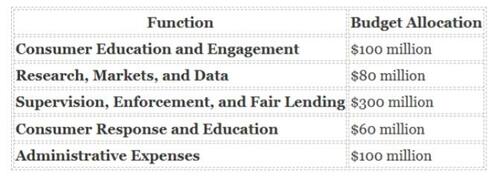
Agency For International Development (AID)
Foreign aid has always been a waste and failure, even in the context of an Empire First foreign policy and quasi-balanced fiscal environment. But under an America First regime and in fiscal conditions literally hemorrhaging red ink, foreign aid amounts to a Sacred Cow that needs to be slaughtered forthwith.
In Chapter 7 we will amplify on how a true America First national security policy would focus almost exclusively on maintaining an invincible strategic nuclear deterrent and a powerful conventional defense of the coastlines and airspace of North America. But suffice it here to note that wasting money Washington doesn’t have on development projects, so-called humanitarian relief, and walking around money for corrupt foreign governments does absolutely nothing for homeland security properly defined.
For want of doubt, here are the 10 largest recipients of U.S. foreign aid (excluding weapons financing) for 2024. Self-evidently, the disastrous proxy war against Russia is enabling Ukraine to absorb the lion’s share of the grift. Yet the result of keeping the Ukrainian government on Washington-infused life support is ultimately a threat, not a boost, to homeland security if it leads to nuclear confrontation with Russia.
Likewise, Ethiopia, Jordan, Somalia, Nigeria, and the now ascendant jihadist opposition forces which overthrew Assad in Syria (who actually get the money) have absolutely nothing to do with safeguarding the liberty of Americans from Maine to Hawaii. And most especially the multi-billion slice of the AID budget which goes to “implementation of the National Strategy for Gender Equity and Equality…(and) to uplift the role of women and girls in all their diversity, including as part of marginalized populations” is purely wokish nonsense utterly irrelevant to national security.
Top Recipients of Non-Military Foreign Aid
-
Ukraine: $16.5 billion
-
Ethiopia: $2.2 billion
-
Jordan: $1.2 billion
-
Democratic Republic of Congo: $1 billion
-
Somalia: $1 billion
-
Yemen: $933.9 million
-
Nigeria: $904.4 million
-
Afghanistan: $815.1 million
-
South Sudan: $794.2 million
-
Syria: $748.2 million
Thus, simply closing the Agency for International Development would rid the Swamp of 10,000 bureaucrats at an annual direct compensation cost of $1.6 billion. But that would be just the tip of the iceberg. AID has offices and operations in more than 70 countries around the planet. And these offices are loaded with bureaucrats in the service of Empire First, who are equipped with checkbooks from which upwards of $30 billion of grants are funded annually.
Indeed, zeroing out AID in its entirety is a downright mandatory component of any attempt to slash the Federal budget by $2 trillion. When America is careening toward a ruinous $150 trillion public debt by mid-century it borders on criminal negligence for Washington to send $794 million per year to the likes of South Sudan. The latter is a godforsaken hellhole in central Africa with a GDP of barely $5 billion and per capita income of just $400. Yet AID is shoveling in assistance equal to more than 16% of GDP!
Even more ridiculous is the fact that while Washington has been bombing the Houthi-controlled northern areas of Yemen to smithereens at a cost to the US military of $3 billion in the last three years alone, it is also sending foreign aid of $933 million per year to the government in the south of the country, thereby enabling the Sunni south to pursue its decades-old civil war against the Shiite north. Perhaps it might be more rational to stop both streams of funding and allow the Yemenis to pursue their own civil war in peace–or at least without supervision and meddling by folks on the banks of the Potomac.
And, no, protecting the shipping lanes into the Red Sea is not a matter of US national security. The Chinese container ships and Saudi oil tankers heading for Europe through the Bab-El-Man-deb Strait can always reroute around the Cape of Africa at a small premium if they deem the Red Sea route too hazardous. And, self-evidently, Washington has no business subsidizing cheaper ocean freight to Europe for the oil princes and Chicoms.
At the end of the day, the Yemen idiocy on display above is no aberration. It represents the inherent stupidity and waste of an imperial foreign policy that attempts to dominate every obscure corner of the planet for no reason of homeland security whatsoever. Therefore, one of the first initiatives of President Trump’s pivot to America First must be the complete shutdown of the AID.
FBI
The Federal Bureau of Investigation is a Washington institution steeped in ignominy and disdain for constitutional liberty and democracy. Its forerunner was created during the horrific Red Scare Raids of Attorney General Mitchell in 1919; it flourished prosecuting the idiotic regime of Prohibition during the 1920s; rose to malefic aspect during the Hoover era of Communist witch-hunting and vicious prosecution of civil rights and peace leaders like Martin Luther King Jr; became a fount of false fear-mongering, stings, and entrapment ploys during the War on Terror; and ended up being weaponized by Deep State nomenklatura to destroy the duly elected President of the United States in 2016 and after.
In short, that’s 100 years of assault on the rule of law, not its promotion. That history is reason enough to abolish the FBI completely, thereby shrinking the Federal payroll by more than 37,000, at a savings of $6 billion in direct compensation costs and another $5 billion in overhead and operating expenses.
The fact is, there never was a need for the FBI in the first place–outside of political opportunism and the furtherance of crusades which are not within the proper purview of the Federal government. Again, however, we have 90,000 units of state and local government for a reason: That is, to decentralize the exercise of government power, and enforcement of the criminal laws is precisely one of those functions best kept as far away from the nation’s capital as possible, as the checkered history of the FBI proves in spades.
In any event, as a practical matter crime prosecution and enforcement is already overwhelmingly conducted by state and local police forces and courts. For instance, there are currently about 7.4 million arrests in the US each year, but only about 10,000 of these are executed by the FBI. That’s just 0.14%.
Likewise, there are currently 1,214,000 police and law enforcement personnel on the payrolls of state and local governments in the US. That compares to just 15,000 FBI officers (out of 37,300 staff) involved in domestic criminal law enforcement. This includes all agents and support personnel who work on a wide range of federal crimes such as cybercrime, drug trafficking, violent crime, and white-collar offenses, but, again, it amounts to only 1.2% of the state and local police force level.
At the end of the day, just $2.5 billion of the FBI’s $11.4 billion budget is involved in what it generously classifies as “counter-terrorism.” We’d say cut that figure by 60% and spin these personnel and activities off to a $1 billion per year counter-terrorism unit in the DOJ. Any real threat of terrorism in the US, as opposed to self-serving FBI concocted stings like the alleged plot to kidnap the governor of Michigan, can be readily handled on a $1 billion annual budget.
After that, close down everything else to the tune of a 34,000-headcount reduction and direct compensation cost savings of $5.4 billion per year–along with another $5 billion of savings from FBI overhead, contractors, occupancy, travel, and other costs.
Drug Enforcement Agency (DEA)
The War on Drugs was misbegotten from the get-go back when Tricky Dick Nixon launched it in 1970. The only thing it has accomplished is to breed criminals and a brutal underground distribution system funded by the wildly excessive profits owing to the artificial scarcity created by drug law enforcement and interdiction. It has also filled the nation’s jails and prisons, mainly on possession charges, thereby providing a taxpayer-funded program where inmates get a free in-house education on how to conduct real criminal activities after their release.
In short, the War on Drugs is a grotesque violation of Market Economics 101. There is simply no other way to characterize the utter stupidity of fostering criminal cartels to do the work of growing, manufacturing, packaging, distribution, and sales that would otherwise be handled by the far more pacific channels of everyday commerce. Indeed, the harsher and more intensive the enforcement against so-called illegal drugs, the greater the amount of crime and the more extensive and tragic the collateral harm that is created as a secondary consequence.
For instance, the plague of fentanyl deaths is clearly owing to the high price of heroin, meth, and other illegal substances stemming from the War on Drugs, which, in turn, encourages the importation and use of fentanyl. Fentanyl is cheaper to produce, easier to smuggle, and extremely potent, making it a lucrative alternative for traffickers. This economic incentive drives its widespread distribution and use, despite its high lethality.
In any event, the surest way to reduce crime at both the borders and in the cities and hinterlands of America alike would be to shut down the DEA cold turkey, releasing 9,300 Federal bureaucrats for more productive work elsewhere. Needless to say, once these hobnailers are off the street, the price of illegal drugs would fall sharply, along with the profitability and incentives for violence among the criminal cartels which run the drug trade.
In all, terminating the DEA would cut its direct compensation cost by $1.5 billion per year, as well as save another $1.6 billion for operations, contractors, and overhead functions. There is hardly any other agency termination candidate where the case is so overwhelming.
Bureau of Alcohol, Tobacco, Firearms and Explosives (ATF)
Ronald Reagan famously said that a government bureau is the nearest thing to eternal life, and surely the ATF is testimony to that aphorism. In 1920 it was born as the Prohibition Bureau, which housed the hated “revenooers.” After the Volstead Act was repealed in 1933 it continued to stumble between the Treasury Department and the Justice Department over the decades, looking for missions to justify continued funding. Even in relative bureaucratic obscurity, it gained notoriety for the armed standoff at Ruby Ridge, the extermination of the Branch Davidians at Waco, Texas, and the gun “misplacement” scandal of Operation Fast and Furious, among numerous other bureaucratic misfires.
Yet an analysis of what its 5,300 employees and $850 million compensation budget actually accomplish makes clear that the time to terminate the agency arrived long ago. There is absolutely no reason for the Federal government to be in the alcohol, tobacco, and explosives enforcement business at all. Those are inherently functions of state and local government, if they are to be legally regulated and enforced at all.
Allocation of ATF’s $1.7 Billion Budget
Likewise, its $500 million budget for “firearms enforcement” is just a polite term for the administration of gun control laws, which self-evidently don’t control much of anything. Thus, the number of deaths–both suicide and homicides–due to guns has more than doubled from 20,336 in 1968 to 47,284 in 2021, which translates to rates of 10.1 per 100,000 population in 1968 and 14.1 per 100,000 in 2021. So much for the ATF’s enforcement prowess.
In any event, whatever these ATF bureaucrats might be doing that is necessary and legitimate should be turned over to regular state and local law enforcement. If any rump agency is needed to enforce largely ineffective federal gun control laws–given that there are upwards of one-half billion guns in circulation in the US–these activities can be seconded to a modest residual bureau in the Justice Department at the approximate size of the Office of Violence Against Women ($500 million).

